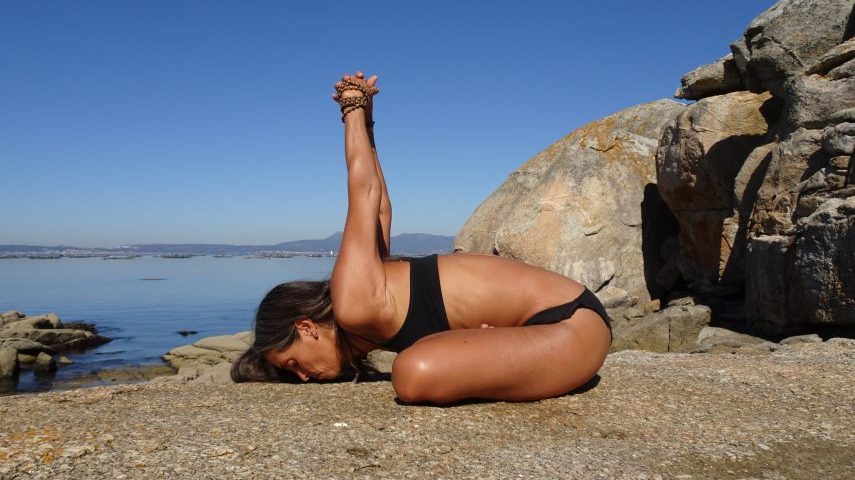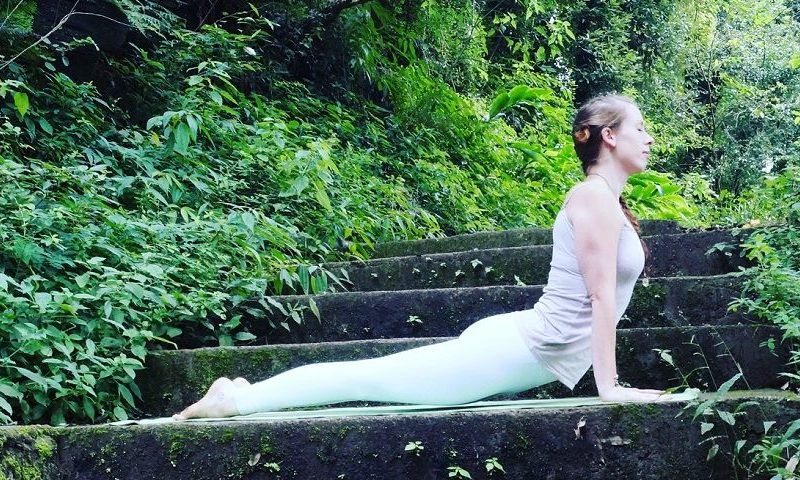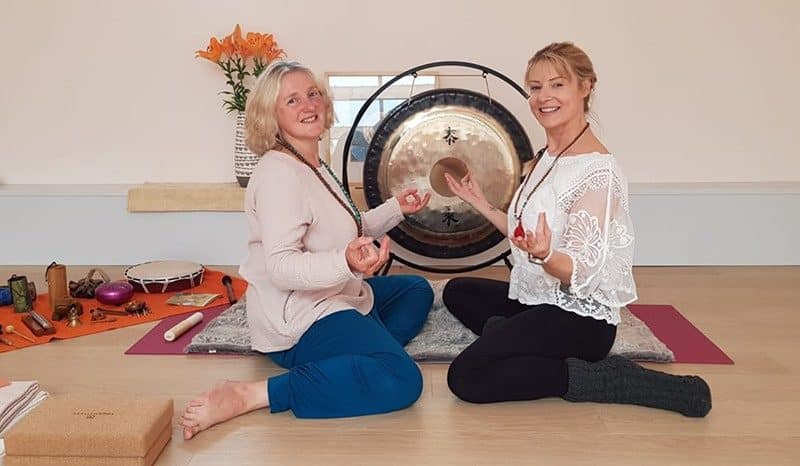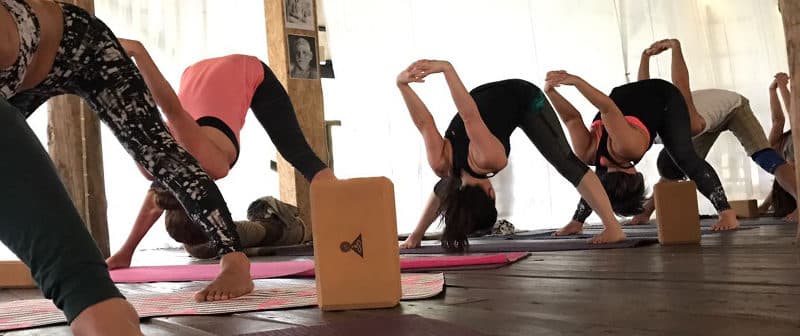Bringing a yin attitude to the world
Immersed in an over-active and too mind-focused Yang society, Yin Yoga provides a functional way to stretch and relax your body, calm down your busy mind and observe your feelings from a peaceful place. Do you want to know more?
1. YIN & YANG
Yin and Yang are the two sides of the “duality” present in everything we perceive according to ancient Chinese tradition. This concept is common to philosophies all over the world.
Although opposite, they need and complement each other in a dynamic and permanent search of balance.
Yin (cloudy, shady) symbolizes the feminine, passive, negative principles of life, like the Moon, the night, intuition or shelter.
Yang (bright, sunny) expresses the masculine, active, positive attributes such as the Sun, day, reason or exposure.
Do you wonder how does them impact our lives? Keep on reading.
2. IN SEARCH OF BALANCE
Our society has become extremely Yang over the Centuries: We are raised and trained to reach, to achieve, to act, to conquer, to expect immediate results, to work with our minds and rationalize. However, the more we do this, the more unsatisfied and troubled we become. Stress, anxiety, chronic diseases, anger or depression are just some of the symptoms in our world A world in which, in theory, we have everything we need and more.
Yin and Yang are not right or wrong by themselves but excess is never good and the need to introduce some Yin qualities to balance the equation seems pretty clear. Can we do that? How?
3. COMMON SENSE: YIN BODY WISDOM & YANG REASON
Where do we find some peace, relaxation and patience to slow down? Let’s use what we have.
Our rational mind, active, yang and restless by nature has taken over and it might even have us controlling our body in the most strange ways, from over-exercising to over-eating (or quite the opposite), over-worrying, etc.
Our body wisdom is yin, our intuition, the certainty that things take time and that’s ok. Our emotional needs are held in the body and we rarely have the capacity of listening to it anymore since we are usually so mind-centered.
Common sense comes from a nice mix of both. They say the mind is a good servant and a bad master, so instead of letting it command, let’s use it to take positive decisions towards recovering that body awareness. A Yin Yoga practice is an excellent way.
4. YANG YOGA vs. YIN YOGA
If you ask me, I’d say there is only one Yoga, it means union and it has the same intention (bringing body, mind and spirit back together) in many different shapes.
In more practical and mundane terms Yang Yoga would be a more dynamic routine in which we activate blood circulation and muscles, increase our heart rate and heat in the body building up strength and resilience.
Conversely, Yin Yoga emphasizes stillness, aims for flexibility in the joints and the fascia through a gentle and sustained stretch, cooling down, grounding and soothing our system.
A healthy body needs Yin and Yang activities, but how many of your routines will qualify as Yin? Do you believe bringing more Yin to your life will benefit you?
Are you familiar with fascia and it’s function?
5. THE FASCIA AND THE MERIDIAN THEORY
The fascia is our connective tissue, the metamorphic matter that literally links our entire body. It wraps and embeds muscles, organs, bones and vessels and if healthy, it glides and slides allowing our movements to be supple and fluent.
Science is paying more and more attention to it, and new discoveries point to information travelling through electric impulses following pathways that resemble the TCM meridians or the Hindu nadis. The fact that it connects everything in the body explains why reflexology works.
Movement, stretching, breathing and other releasing techniques help remove adhesions and stiffness in the connective tissue promoting also a healthy flow of the lymphatic system.
There are many benefits your body can get from practising Yin Yoga, but there’s much more than that.
6. YIN YOGA: BRINGING YIN TO YOUR MIND THROUGH THE BODY
In a Yin Yoga practice you stay for several minutes in a posture, therefore it’s good to get used to find a reasonably “easy” one. Time and gravity will naturally increase the intensity of the stress in the target areas while intentional breath will help us release unnecessary tension and allow us to sink into the posture.
There are many things happening under the appearance of a languid stillness: Witnessing the subtle changes in our perception, developing body awareness, befriending any available support (floor, mats, our own body), directing our breath or learning to stop controlling it. All of it means our attention and will are present, “busy” in a passive way, engaged, for a change, in quite Yin matters that connect our Parasympathetic Nervous System and slow our brain waves contributing to our best possible rest, and restoration.
Many Yin practitioners, me among them, enjoy especially this “meditative” aspect of the practice in which the monkey mind fades away to join the body in its deep surrender and allow small but significant discoveries and changes to surface.
7. A YIN ATTITUDE TOWARDS LIFE
Yin Yoga is a suitable practice for everyone that promotes physical, mental and emotional health and complements whatever other active exercises that you do.
In my experience is also an easy and supportive way to develop acceptance, patience, control of our impulses, detachment or compassion and include them in your daily life. It is not the only way, for sure, but in our society we’ve managed to turn many yoga styles in a body-building & circus competition (and it’s beautiful to witness how true yogis come into impossible shapes, but the shape a side effect). It is not the image that counts, but every step, every breath, every discovery and reconnection and the possibility of leaving the pose and taking the attitude with you to balance your life and be happier.
Want to try?




5 Comments
Yin = the feminine and negative aspects of life?!
“Yin (cloudy, shady) symbolizes the feminine, passive, negative principles of life, like the Moon, the night, intuition or shelter.”
Hello, Thanks for your comment. Yes, negative like in electricity. It is not in the sense of bad or wrong. Both positive and negative, dark and light, passive and active aspects are necessary and work in a permanent search of balance. Does this answer your question? Namaste
Hi Teresa, thanks for this thoughtful article. A yang society indeed! It seems it’s getting faster every year. It reminds me of a quote I came across in a mindfulness book: “Given that mental-health problems are increasing across society, within a few decades the default human condition will become one of chronic pain, anxiety, stress and depression, rather than being characterised by quiet contentment and happiness.” – Mindfulness for Health: Relieving Pain, Reducing Stress and Restoring Wellbeing (Ch. 2, p. 18). This is why we need Yin Yoga! I also wrote about restorative yoga recently – I think it adds to this conversation. Let me know your thoughts! Here’s to “rest & digest”! https://www.zenyoga-berlin.de/blog/restorative-yoga-how-does-it-work/. Greetings from Berlin!
Hi Tatiana. Teresa replied you comment. Thanks for your opinion
Namaste Tatjana!
My apologies for a late response. I had the chance of reading your article just a minute ago. Thanks for sharing! I agree with the facts that you state and I will go even further than that as I believe Yin and Restorative are a great way to tap into our feelings and deal with them.
Maybe we can personally talk about all this as I will be in Berlin from July 2nd to 11th assisting Jo Phee in her Spine Module TTC!
Looking forward to arriving to your beautiful city!!!
Blessings